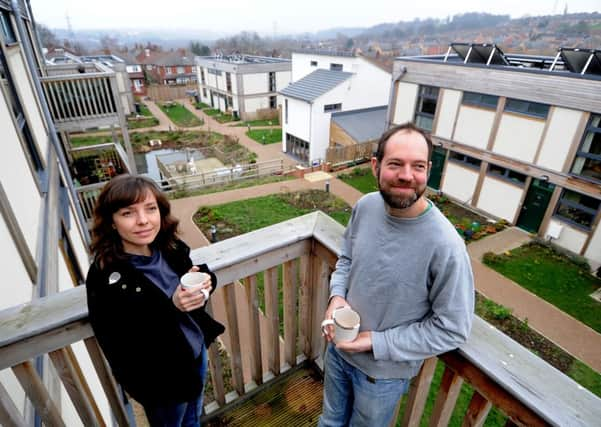Why LILAC co-housing scheme in Leeds is still setting trends two years on


Snug in draught-free and affordable straw-bale homes with fuel bills of next to nothing, Eden Ballantyne and his neighbour Lara Eggleton are evangelical about the pioneering co-housing complex they call home.
They have to think long and hard about the negatives, which turn out to be pretty positive after all.
Advertisement
Hide AdAdvertisement
Hide Ad“It is a sociable place, which is great but you often get chatting to someone as you are heading out, so I am often late for things. I have to factor in an extra 10 minutes when I leave to catch a train,” says Lara, who adds that her apartment’s eco bath is a bit too shallow for her liking.
It does save water though, which is part of the ecological ethos of LILAC, the Low Impact Living Affordable Community, which opened two years ago.
The venture started with Leeds University geography lecturer Dr Paul Chatterton and a group fellow idealists who wanted to create eco-friendly, affordable homes and a caring, sharing community. And like all good ideas, it began life on the back of a beer mat.
Two years on, however, and it seems that they have succeeded in creating a property nirvana that combats everything from fuel poverty to loneliness.
Advertisement
Hide AdAdvertisement
Hide AdIt took five years to source funding and land to build this new way of living. They eventually found a site at a former school in Bramley, Leeds, while funding for the £2.7m project came from members’ investments, a £400,000 government grant and a mortgage from a Dutch bank.
The 12 apartments and eight houses are built from straw bale covered in lime render and cedar cladding and social interaction has been designed in.
None of the homes have washing machines or dryers. Instead, residents use the on-site laundry, which is a natural meeting point.
A separate common house acts as the community hub with a kitchen and dining hall for twice-weekly shared meals, a post room, event space, an office with a communal printer and a workshop with tools and gardening equipment.
Advertisement
Hide AdAdvertisement
Hide AdOutside, there are allotments, a play area and a parking area, although only 10 people have cars, which they share with other residents.
It is a 21st century commune that allows everyone their own privacy while encouraging them to share resources and socialise.
The 36 LILAC dwellers now range from babies to octogenarians, from a GP, paramedics and teachers to counsellors and retirees.
Passion drove the project but it is the complex financial model that made it happen.
Advertisement
Hide AdAdvertisement
Hide AdResidents put down a deposit of 10 per cent of the property’s value and then pay 35 per cent of their income each month.
This buys them shares, which they can redeem when they leave. They get back what they have paid in, minus 10 per cent running costs.
“It’s somewhere between renting and owning. Paying 35 per cent of our income is good because it means that low earners can also afford to live here.
Fuel bills are extra but mine are only £10 a month,” says Eden, a professional storyteller.
Advertisement
Hide AdAdvertisement
Hide AdAll residents are on various task teams and also take turns cleaning the communal areas and cooking the shared meals, which aren’t compulsory.
The meals have to be vegetarian as half the residents are non-meat eaters and a residents’ meeting decided it was better for the environment. All decisions have to be reached by consensus.
“It teaches you how to compromise and it’s interesting listening to ethical and moral dilemmas. The big decisions are usually sorted quickly but little things like what colour to paint something can take several meetings,” says Lara.
While it all sounds very appealing, getting a place here is difficult, not least because few people want to leave.
Advertisement
Hide AdAdvertisement
Hide AdThose who want the chance to live the LILAC way have to be vetted to see if they will fit in – and they have to be in work. Meanwhile, other groups, including one in Bradford, are trying to replicate the co-housing project against considerable odds.
Finding affordable land and getting finance are still major issues. Until they succeed, LILAC’s social and financial experiment continues to be a one-off and the subject of fascination.
Those who founded LILAC were well aware they were making a social statement when they took on the challenge - at the heart of their philosophy are terms like social justice and self-management. Decision making on issues which affect tenants is done by committee.
Sitting in the middle of what is a very built-up area, LILAC looks more as though it belongs on some windswept Nordic hillside with its weathered angular wooden exterior. In parts, the old school railings remain but look through them and you’ll spot vegetable plots and garden implements.
Advertisement
Hide AdAdvertisement
Hide AdGeography and sociology students are a common sight, while neighbours in the surrounding red-brick terraces and semis speculate about what goes on within the straw-bale walls.
When they discover what it’s all about, they may well want to abandon conventional living for LILAC’s affordable and infinitely more convivial lifestyle.
* www.lilac.coop